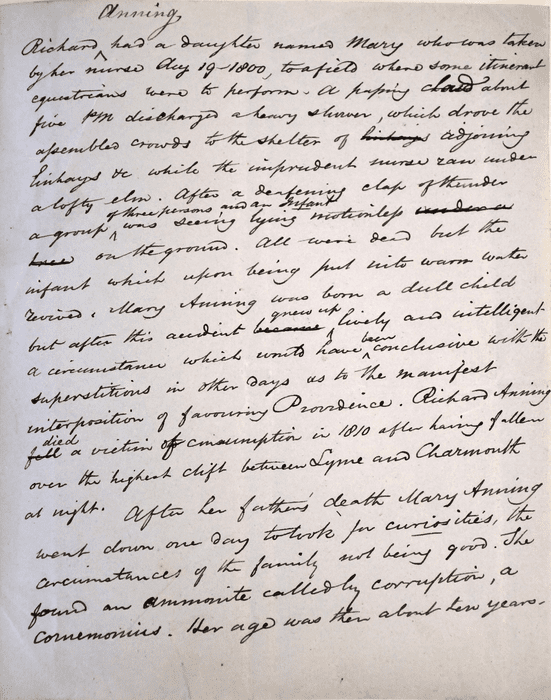Fossil hunter Mary Anning not only helped find the first intact ichthyosaur fossil and the first pterosaur outside Germany, but was the first to identify coprolites as fossilized poop. At a time when both women and the working class were largely excluded from practicing science, her capacity to break through both barriers was remarkable – even if upper-class men often took the credit.
The content of the biography, believed to be written by local schoolmaster and mayor George Roberts sometime between 1937 and her death in 1847, may increase understanding of this important figure. Its existence alone also shows she was more recognized during her lifetime than has sometimes been imagined.
Anning’s contributions were never entirely forgotten, but they were downplayed for a long time. Campaigns to correct the erasure of women in science have raised her prominence in recent years, leading to the book Remarkable Creatures, the film Ammonite and a crowdfunded statue in Lyme Regis, where she lived. Publication of the resurfaced biography in the Journal of the Geological Society fills in some detail.
Anning made her living selling fossils she collected on Dorset’s Jurassic coastline to tourists and scientists alike. Roberts ran a school across the road from her shop and wrote books on the region for tourists, one of which included a section on Anning.
A four-page handwritten document about Anning was preserved in the University of Bristol’s special collection on the history of geology, although how it got there is unknown. The library sent it to Dr Michael Taylor of the University of Leicester for analysis, who recognized the similarity to the passage in Roberts’ book.
“We were able to confirm Anning expert Hugh Torrens’s suggestion that it was by Roberts, by identifying Roberts’s handwriting, and comparing the corrections and even a mistake with a particular date which Roberts had handwritten into his own copy of his history,” Taylor said in a statement. “So, it wasn’t just someone else copying from his book. It looks as if it was written as a dictionary entry or a section for a future book.”
Page three of the manuscript describing Anning’s life. Image Credit: Special Collections, University of Bristol
The document refers to Anning as a “living worthy”, and the paper it is written on is watermarked to 1837, dating the piece to the last ten years of Anning’s life.
Roberts published a much shorter version in the Athenæum after Anning’s death, and this formed the basis for obituaries in more than 20 papers and scientific journals. Their publication, and the £25 public annuity granted by the British government in 1836 on request of the Geological Society of London, indicate she maintained a substantial public profile at the time. It was only after her death her contributions were forgotten for a time as the authors of papers on her discoveries got the credit.
“We are very pleased that we are able to publish the document in full,” said Bristol University’s Professor Mike Benton. “In the paper, we show detailed photographs of all four pages of the document, as well as our reading of the various versions and modifications.”
Besides describing her work, the document tells the story of how Anning, aged one, survived being struck by a lightning bolt that killed her nurse and two others. “Mary Anning was born a dull child but after the accident became [grew up inserted] lively and intelligent,” Roberts wrote. Lightning strikes are nevertheless not recommended as a method for engendering genius.
Roberts has not been described as a fossil collector himself, but he wrote the first dictionary of geological terms to encourage his students and other young people to take an interest in the field.
The original document and Taylor and Benton’s comments is available at the Geological Society Publications.
Source Link: A Mary Anning Biography That Was Written In Her Lifetime Is Finally Published
